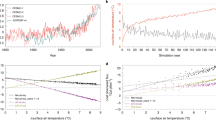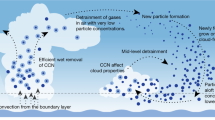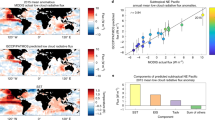Abstract
RECENT discussions of the effect of cloud condensation nuclei (CCN) in controlling the albedo of marine stratus cloud and hence global climate1–3have raised questions concerning the factors that control CCN populations and how (or whether) such factors should be included in climate models4. The observed near-constancy5 of CCN concentrations in remote marine air is remarkable in view of the wide variety of possible conditions, the range over which they might be expected to vary, and the considerable difference between marine and continental CCN concentrations. Here we explain this relative lack of variability, thought to be due to a balance of source and sink processes6,7, in a simple model of the marine cloud-topped boundary layer. Solutions to this model give two stable CCN concentration regimes—one corresponding to the low concentration observed over the ocean, the other corresponding to the higher concentration observed over land—each dominated by a different sink mechanism. The two regimes have very different optical properties, and thus may be of climatic significance.
This is a preview of subscription content, access via your institution
Access options
Subscribe to this journal
Receive 51 print issues and online access
$199.00 per year
only $3.90 per issue
Buy this article
- Purchase on Springer Link
- Instant access to full article PDF
Prices may be subject to local taxes which are calculated during checkout
Similar content being viewed by others
References
Twomey, S. Atmospheric Aerosols 287–290 (Elsevier, Amsterdam, 1977).
Charlson, R. J., Lovelock, J. E., Andreae, M. O. & Warren, S. G. Nature 326, 655–661 (1987).
Albrecht, B. A. Proc. Symp. on the Role of Clouds in Atmospheric Chemistry and Global Climate 9–13 (Am. meteor. Soc., Boston, 1989).
Albrecht, B. A. Science 245, 1227–1230 (1989).
Pruppacher, H. R. & Klett, J. D. Microphysics of Clouds and Precipitation 226 (Reidel, Dordrecht, 1978).
Junge, C. E. Air Chemistry and Radioactivity 120 (Academic, New York, 1963).
Junge, C. E. Air Chemistry and Radioactivity 190 (Academic, New York, 1963).
Bigg, E. K. Atmos. Res. 20, 82–86 (1986).
Fuchs, N. The Mechanics of Aerosols 29 (Pergamon, Oxford, 1964).
Turton, J. & Nicholls, S. Q. JI. R. met Soc. 113, 969 (1987).
Betts, A. J. atmos. Sci. 42, 2655–2670 (1983).
Betts, A. J. atmos. Sci. 44, 2751–2763 (1985).
Betts, A. & Ridgway, W. J. atmos. Sci. 45, 522–536 (1988).
Andreae, M. O. et al. J. atmos. Chem. 6, 149–173 (1988).
Tucker, S. thesis, Univ. Washington (1989).
Liou, K.-N. & Ou, S.-C. J. geophys. Res. 94, 8599–8607 (1989).
Warren, S. G. et al. Global Distribution of Total Cloud Copver and Cloud Type Amounts over the Ocean Tech. Rep. DOE/ER-0406, NCAR/TN-317 +STR (National Center for Atmospheric Research, Boulder, 1989).
Author information
Authors and Affiliations
Rights and permissions
About this article
Cite this article
Baker, M., Charlson, R. Bistability of CCN concentrations and thermodynamics in the cloud-topped boundary layer. Nature 345, 142–145 (1990). https://doi.org/10.1038/345142a0
Received:
Accepted:
Issue Date:
DOI: https://doi.org/10.1038/345142a0
This article is cited by
-
The Radiative Forcing of Aerosol–Cloud Interactions in Liquid Clouds: Wrestling and Embracing Uncertainty
Current Climate Change Reports (2018)
-
Aerosols in the Pre-industrial Atmosphere
Current Climate Change Reports (2017)
-
Interactions between aerosol absorption, thermodynamics, dynamics, and microphysics and their impacts on a multiple-cloud system
Climate Dynamics (2017)
-
Resilience of persistent Arctic mixed-phase clouds
Nature Geoscience (2012)
-
Precipitation-generated oscillations in open cellular cloud fields
Nature (2010)
Comments
By submitting a comment you agree to abide by our Terms and Community Guidelines. If you find something abusive or that does not comply with our terms or guidelines please flag it as inappropriate.



